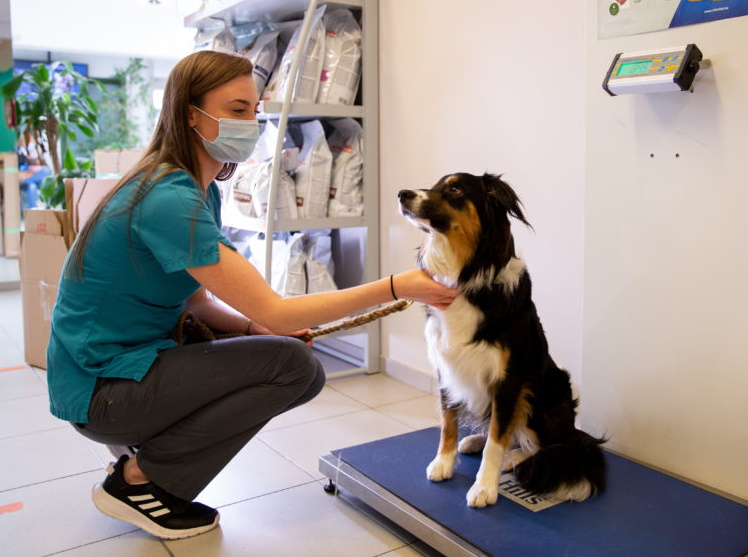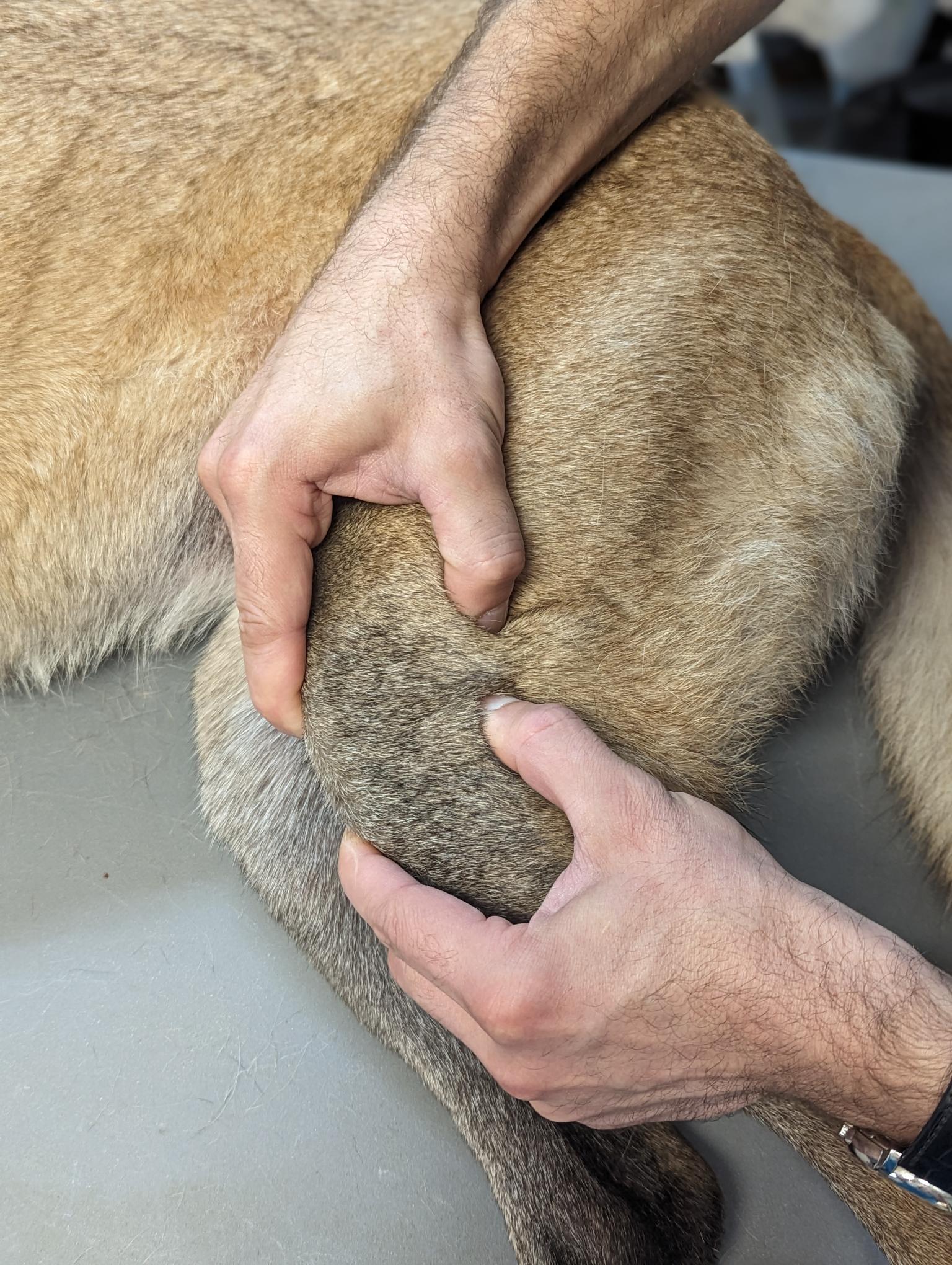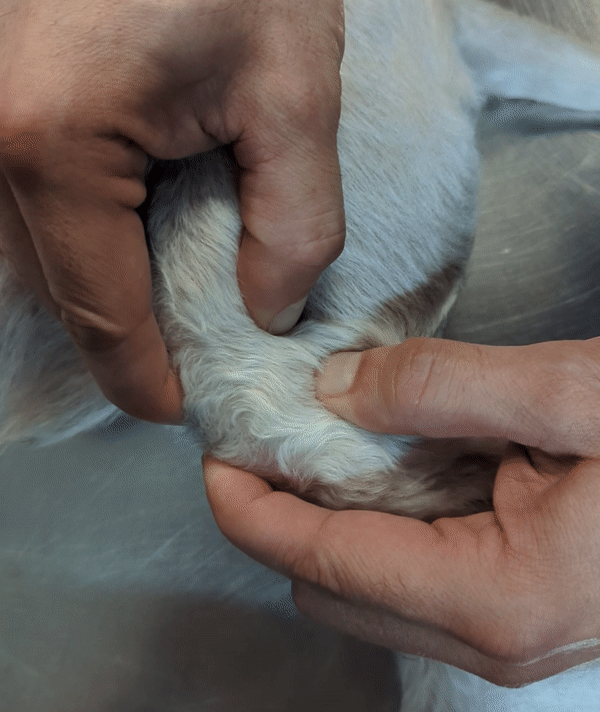Canine cruciate ligament rupture (CCLR)
If your dog is diagnosed with a cruciate ligament rupture, you need to be aware of the importance of prompt treatment. Damage to the anterior cruciate ligament can lead to instability of the knee joint. Prompt diagnosis and treatment can prevent the premature onset of osteoarthritis, improve your dog’s quality of life and, in some cases, even extend his life expectancy.
A dog with lameness or restricted mobility is often a sign of an underlying orthopaedic problem. Often associated with pain, the pet owner may notice a tendency to relieve or even not put down the limb at all when walking. These observations justify a visit to your veterinarian to determine the cause of the problem observed.
If you can identify the knee as an area of pain, it may be a suspected rupture of the anterior cruciate ligament or luxation/subluxation of the patella.
Rupture of the anterior cruciate ligament (ACL) is one of the most common orthopedic conditions in dogs. Some breeds are more prone to this condition than others (e.g. large dogs and/or those with powerful muscles).
Structure and function
The knee joint in dogs connects the femur to the tibia and fibula. The cruciate ligaments form an X-shaped structure, running from the front of the joint to the back of the knee. This structure is a key element of the joint’s stability. It prevents the two major bones from moving forwards or backwards. It also allows the joint to twist along its long axis without dislocating.
Anterior cruciate ligament
The anterior cruciate ligament is a very important structure in the knee, at the heart of the joint. The ligament helps to strengthen and stabilize the knee, enabling the joint to function with normal movement.

The diagram shows instability of the tibia in relation to the femur (arrow to the right) due to rupture of the cruciate ligament.
Diagnosis
Sudden or progressive posterior lameness should alert the owner to a possible rupture of the anterior cruciate ligament. ligament. A consultation with your veterinarian will confirm whether or not this type of damage is present.

Diagnosing the rupture
Rupture of the anterior cruciate ligament can be caused either by acute trauma (rare) or chronic degeneration (most cases). The most common age of onset is between 4 and 6 years.) The lesion may be severe (total rupture), or only a partial tear.
Acute rupture is usually associated with a traumatic event (fall, various accidents). Dogs with these lesions often exhibit severe lameness, avoiding the paw altogether. The joint is often swollen and painful to handle.
More commonly, damage to the anterior cruciate ligament is probably caused by chronic degeneration, leading to joint instability. This degeneration can lead to inflammation and damage to the joint cartilage, as well as meniscus tears.
The cartilage in turn begins to degenerate and erode. This signals the onset of osteoarthritis, which can lead to permanent joint dysfunction.
Inflammatory lesions generally appear within a week of trauma. This is why prompt treatment of the affected joint is critical to the prognosis for recovery. The joint must therefore be stabilized as quickly as possible to enable the dog to return to normal activity.
Diagnosis
Your veterinarian can diagnose a rupture of the anterior cruciate ligament by palpation, accompanied by an X-ray examination. He or she will manipulate the knee to detect what is commonly known as a “drawer sign”.
This will reveal abnormal (forward) movement of the tibia in relation to the femur, when the latter is normally held in a stable position. In the case of violent trauma, X-rays can rule out the suspicion of fractures or other lesions. In the case of chronic rupture, X-rays can identify the presence of osteoarthritis and assess the extent of damage.


Treatment
Fortunately, there are effective treatments for anterior cruciate ligament rupture, offering a prognosis of 90-95% complete recovery. Several surgical techniques are available to replace the cruciate ligament and/or stabilize the joint.
The technique selected by the veterinarian depends on the size of the dog, the duration of the condition, and the biomechanical aspect of the joint. Whatever the technique, the aim of surgery is to stabilize the joint and prevent the onset of abnormal movements that lead to arthritic degeneration.
Medical treatment with anti-inflammatory drugs helps relieve both pain and inflammation, but cannot be curative.
We offer 2 types of intervention to achieve the highest standards of treatment currently available:
TPLO surgery
This is a procedure to correct the angle of the tibial plateau, the most widespread and recommended technique over the past twenty years.

Ligament prosthesis
Anterior cruciate ligament (ACL) replacement surgery using a ligament prosthesis placed arthroscopically (NOVETECH equipment) enables the ligament to be replaced in a physiological, non-invasive manner, allowing rapid functional recovery and joint function identical to that prior to rupture.
The use of fibers (UHMWPE), which have proven their biocompatibility, offers a strength of almost 8,000 Newtons, well above that of the original ligament.

These two techniques are currently the best options available worldwide for the treatment of ACL rupture.
